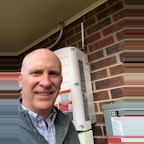Solar
Marketing and Sales
Energy Finance
Commercial Electric Tariffs: Impacts on Solar

About this course
Selling solar to commercial customers requires a keen understanding of how local electric tariffs affect their utility bills, because their utility bills will most certainly affect a solar system's financials (also known as payback period).
In this quick but critically important course, HeatSpring instructor Matt McNearney uses his real-world commercial solar development experience to explain key concepts like demand charges, straight usage, and time of use tariffs. This knowledge is then applied to two case studies that show the differences between commercial rate structures and the varied impacts that each can have on solar PV systems.
This course is a must for anyone working in commercial solar sales and development.
This course is included in HeatSpring PRO
Subscribe and start learning to earn the following badge.

Skilled Sales PRO
4
courses
Worth
$2,000+
Course outline
7 modules
2 hours to complete
1:06 hours
of video lectures
Welcome • 2 assignments
Orientation Materials
Welcome • 2 assignments
Orientation Materials
This course is self-paced, so you don’t need to be logged in at any specific time. You can get started immediately after you enroll and the course materials will remain in your account with minimum guaranteed access for 12 months (1 year) after enrollment.
Loading assignments…
Module 1 • 1 assignments
Overview & PV System Details
Module 1 • 1 assignments
Overview & PV System Details
Provides an overview of the three commercial tariffs that will be presented and the PV system that will be used to demonstrate the impacts of those tariffs.
Loading assignments…
Module 2 • 2 assignments
Demand Charges
Module 2 • 2 assignments
Demand Charges
Explains demand charges, including how they set and the limited impact that solar has on them. Includes pulling key data from a monthly billing statement and how to apply a simple financial analysis that emphasizes annual value and payback period, which is well suited for a relatively small project.
Loading assignments…
Module 3 • 3 assignments
Straight Usage & Time of Use
Module 3 • 3 assignments
Straight Usage & Time of Use
Shows how alternative commercial tariffs based on straight usage and time of use would affect our case-study PV system. It goes on to present a side-by-side comparison of the three commercial tariffs and walks you through the decision made by the client.
Loading assignments…
Module 4 • 1 assignments
Case Study 2: ABC Insurance
Module 4 • 1 assignments
Case Study 2: ABC Insurance
Shows how the tariffs would affect a larger PV project, including the advantage of using additional financial metrics such as Return on Investment and Internal Rate of Return to determine a project's viability. Also emphasizes potential ideas for how to approach a client whose financial return on their solar investment may seem low.
Loading assignments…
Module 5 • 2 assignments
XYZ Revisited & Wrap-Up
Module 5 • 2 assignments
XYZ Revisited & Wrap-Up
Takes a second look at the XYZ Consultants project to see how the additional financial metrics used for the ABC Insurance project might have changed how the proposal would have been presented. It then wraps up the course by highlighting the key points that we covered on the impacts that commercial electric tariffs have on PV systems. The module concludes by showing how all clients, regardless of their tariff, can be considered good solar candidates.
Loading assignments…
Conclusion • 4 assignments
Feedback and Additional Resources
Conclusion • 4 assignments
Feedback and Additional Resources
This is our last module but you still have access to the all of course materials for 12 months (1 year), so keep working and you'll be able to complete the course at your own pace. After your year of access expires you can optionally extend access with a HeatSpring Membership. Enjoy the course and keep in touch!
Loading assignments…
Continuing Education Units
Instructor
Over the past 8 years, Matt McNearney has developed over 65.3 MW of solar across community solar gardens, commercial rooftops, multifamily dwellings, and residential homes. Prior to entering the solar industry, he spent over 25 years developing books and software in the renewable energy, telecommunications, and educational markets. He served four years on the Energy...
Frequently asked questions
Full FAQHow does this course work?
This 5 module course is delivered entirely online. This course is self-paced and you can set your own schedule to complete the materials. During your year of access the instructor will be in the course answering questions on the discussion board. After successfully completing the course, you will be able to generate a certificate of completion.
How long do I have access to the materials?
Students can pre-order but will not be able to access the full course materials or earn a certificate of completion until the course is fully published. Once the course is published any students who have pre-ordered will then have access to the course materials for one year (365 days). After the one year of access expires, access can be extended by joining as a HeatSpring member. A single membership extends access to course materials for all past enrollments.
Is there a certificate of completion?
Yes, when you complete this course you are eligible for a certificate of completion from HeatSpring. You can download your certificate as soon as you have completed all of the course requirements. Students can easily share their verified certificates on their LinkedIn profiles using our LinkedIn integration.
Can I register multiple people?
Yes please visit our HeatSpring for Teams page to get a group discount.
